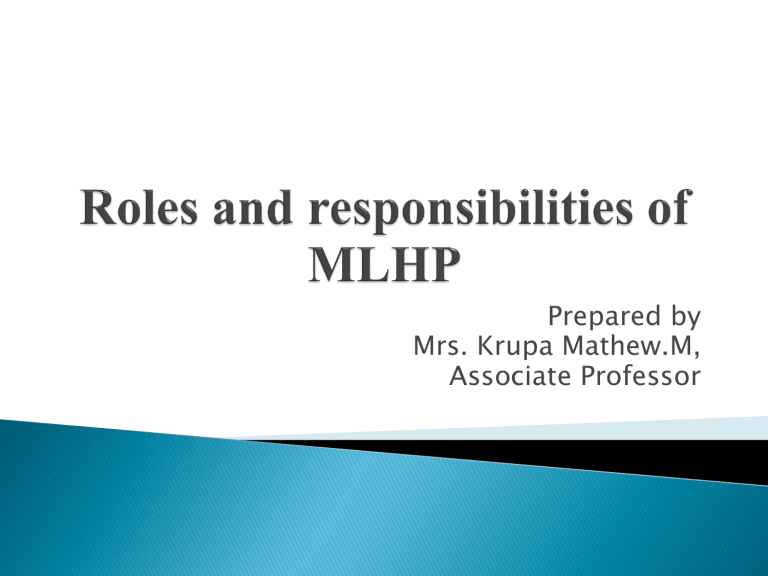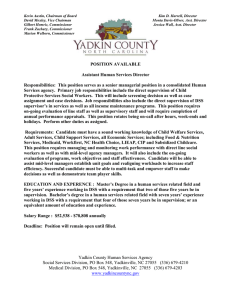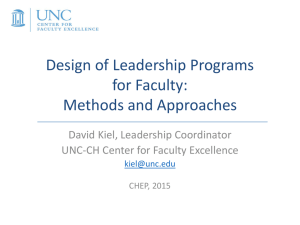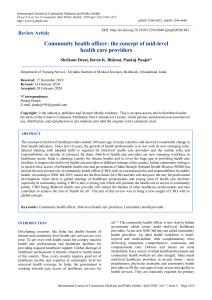
Prepared by Mrs. Krupa Mathew.M, Associate Professor The concept of mid-level health providers started 100 years ago in many countries and showed a remarkable change in their health indicators. Since last 10 years, the growth of health professionals is in rise with its new emerging roles. Mid-level health care providers are new emerging workforce in healthcare sector. India is alarming country for disease burden and to cover the huge gap in providing health care facilities, it requires the mid-level health care providers at different settings of the country. . In order to provide quality primary health care In 2019, a new Mid-level Health Care Provider role was introduced in India, also known as Community Health Officer/ Community Health Provider. The role was intended for support the health and wellness centres in community Mid-level practitioners, also called assistant practice clinicians and non-physician practitioner, are trained health care providers who have a defined scope of practice This means that they are trained and legally permitted to provide healthcare in fewer situations than physicians and some other health professionals, but more than other health professionals. Mid-level providers are cost-effective in primary care settings, where they can relieve physicians of the necessity of providing routine care. Community health officers play a role to bridge the gap between community people and health care facilities. The services provided by them improve the quality of life in community and also empowers the community health care settings According to WHO, Mid Level Health Provider is : A health provider: Who is trained, authorized and regulated to work autonomously, Who receives pre-service training at a higher education institution for at least 2-3 years, and Whose scope of practice includes (but is not restricted to) being able to diagnose, manage and treat illness, disease and impairments (including perform surgery, where appropriately trained), prescribe medicines, as well as engage in preventive and promotive care. Studies reported around 11.5% households in rural areas and about only 4% in urban areas, are not receiving any form of OPD care at sub- centre, primary health centre and CHC level. This indicates the low utilization of primary health care for minor ailments or it may be because of inefficient health-care services or unavailability of healthcare providers. In order to expand access to comprehensive primary health care (CPHC), government of India has launched Ayushman Bharat - Pradhan Mantri Jan Arogya Yojana (PMJAY) in Sept, 2018. PMJAY is a centrally sponsored scheme. Under this scheme - health and wellness centres (HWCs), sub health centres (SHCs), and primary health centres (PHCs) are being strengthened as health and wellness centres (HWCs). The services in HWCs will be provided through a midlevel health care provider (MLHP)/community health officer (CHO) placed at a HWCs and medical officer at PHC (rural/urban). The MLHP/CHO will undergo a certificate in community health through IGNOU or public university Community health officers are health care workers with training less than that of a physician but greater than that of more ordinary nurses and other medical assistants. India is a second most populous nation in the world and also a developing country. As per WHO, by 2024 the projected population would be 1,447,560,463. With this growing population, India is in a great demand of doctors and nurses. At present India has a shortage of an estimated 600,000 doctors despite of more than 529 government and private medical colleges having an annual intake of 70,978 students Community health officer will bridge the gap between population and sub- centre, primary health centre and community health centre. CHO’s are permitted to serve the community independently to diagnose, manage and treat minor ailments and impairments and also engage in preventive Expended Service Delivery. Continuum of Care – Tele-health/ Referral. Their expanding roles are more helpful for low- and middleincome countries, as a strategy to overcome the shortage of health care workforce challenges and improve access to essential health care services. So, the MLHP or CHO or mid-level practioner (MLP) or community health provider (CHP) are sounds the same and ultimately it means the majority of nurses will be in this role. CHO roles and responsibilities are purely population oriented in public health. They are expected to provide specific service delivery, leadership, supervision, management and take pro-active role in all the activities at community level, organize various health program and activity in health promotion according the need These roles of CHO help to bridge the gap between health care facilities and population seeking health care. Roles are: 1. Health care services 2. Administrative and supervision services 3. Other services Maternal health care: Prenatal care like antenatal checkup, screening for high risk, immunization and supplementation, child birth, postnatal care and if require referral to higher center. Neonate and infant health care: Management of high-risk newborn, screening of congenital anomalies, IMNCI services, immunization. Childhood and adolescent health care: Adolescent health counselling, identification of drug abuse, detection of any deficiency, nutritional supplement and referral services. Reproductive health care: Family planning, prevention and management of STI, identification of gynecological problems and referral services. Communicable diseases: Diagnosis and treatment of vector or water borne diseases, provision of DOTs and DPMR (disability prevention and medical rehabilitation) services for leprosy along with referral services. Illness and minor ailments: Identification and management of fever, respiratory infection, diarrhea, cholera, skin rashes, pain, typhoid, etc. Non-communicable diseases: Screening, prevention, control and management along with follow up and maintenance of treatment modalities. Eye and ENT: Screening along with primary care of ophthalmic and ENT problem and referral services of any emergency. Oral health: Regular checkup and screening of oral health. Geriatric and palliative care: Health camp organization routine checkup. Emergency services: Burn, injury, trauma along with first aid management. Mental health care: Screening and counseling along with referral services. Administrative services: Guidance to other co-health workers and maintain inventory, report submission. Supervision: Supervision of national health program, ASHA, home visits, health promotion activities Care pathway: Provide specific care according to standard treatment guidelines. Case coordinator and manager: Provide communication to higher authority regarding specific case, coordinate in care and management of care. Disaster and outbreak of disease: Local response to disease outbreak and early management of disaster. Fund management: Support the team for entitling the fund for various projects and program. Data management: Record population data with various health indicator and communicate it. Environmental role: Education to community, speak about safe water, sanitation, disposal of waste, pollution control and identify environmental hazards and control Communication skills, interpersonal relationship skills, transcultural competence, assessment skills, training capability, professionalism, advocacy, education and facilitation Since we have shortage of doctors and specialists, the shift in role to mid-level health care provider will relieve the overburdened doctors and specialists, at least in rural health setting Mid-level health care provider has the limited licence only in primary and preventive healthcare to practice medicine at midlevel, who qualify the criteria as may be specified by regulations which will have an overwhelming representation of doctors. This initiative by government of India will help to provide easy and affordable health care services to the population which also play an important role for universal health coverage in India. 1. 2. 3. 4. World Health Organization, Global Health Workforce Alliance. The Kampala Declaration and Agenda for Global Action. Geneva: WHO; 2008. International Labour Organization. The International Standard Classification of Occupations (ISCO-88). Geneva: ILO; 2004. World Health Organization, Western Pacific Region. Mid-level and nurse practitioners in the Pacific: models and issues. Manila: WHO/WPRO; 2001 Desai S et al. Int J Community Med Public Health. 2020 Apr;7(4):1610-1617


